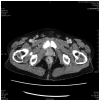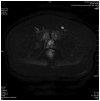Prostate cancer incorrectly diagnosed as a rectal tumor: A case report
- PMID: 26137121
- PMCID: PMC4473363
- DOI: 10.3892/ol.2015.3100
Prostate cancer incorrectly diagnosed as a rectal tumor: A case report
Abstract
Colorectal cancer is the third most commonly diagnosed type of cancer in the world. Prostate adenocarcinoma is the most common male genitourinary tract malignancy, usually occurring after the age of 60. Prostate adenocarcinoma is a highly metastatic cancer. The common metastatic locations of prostate cancer are the bone, lung and liver. The elective locations are bones. Solitary rectal metastasis of prostate cancer is relatively rare. In the present study we report a case of solitary metastasis of a prostate adenocarcinoma with the prostatic capsule intact, which initially led to an incorrect diagnosis.
Keywords: prostate adenocarcinoma; rectal metastasis.
Figures




References
LinkOut - more resources
Full Text Sources
Other Literature Sources
